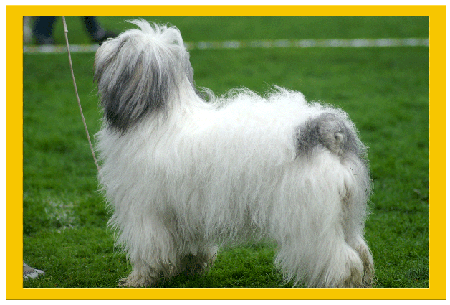

Moonlake Pons - Sweden
![]()
|
The Path To Selective Breeding .
. . continued Evaluating the Breeding PairIn judging, the AKC discourages “fault judging”, in other
words, while admitting to the faults in a particular dog, we should judge
the dog on the qualities that we see. The same is somewhat true in breeding.
The dog that some may consider too small, although within standard,
may have qualities that a particular bitch could use, correct coat
texture, heavier bone structure, etc.
In some cases the qualities far outweigh the faults. While we all hope to produce a litter that is successful in
the show ring, some of the faults that we deal with are not able to be
corrected within the first generation.
That is why it is very important to know the history of each dog
and the faults that have been present in past generations.
Ignoring structural faults and/or genetic health problems in past
generations is sentencing the breed to a questionable future.
Without getting into genetic statistics let me just say that
breeding opposite extremes will not correct a fault in all puppies
resulting from such a breeding.
The Working Dog website features numerous articles and books on the
genetics of dog breeding at http://www.workingdogs.com/genetics.htm
Another source of material is Dog Wise at http://www.dogwise.com/ This is where we revert back to the section in
last month’s article on “Criticism and Evaluation”.
We must first recognize the faults of the breeding pair to
determine where correction can be made and IF it can be accomplished. I have always used a system in which I jot down
on paper two columns, faults and qualities.
For the bitch I list her faults, whether major or minor.
I then do the same for the dog.
REMEMBER! Be Objective
and Honest! Let’s say that one of the faults on the bitch
is a soft coat. Does the dog
possess a correct coat texture AND does he come from a background of
correct coat texture? Let’s
say that one of the bitch’s best qualities is her correct rear
angulation, resulting in correct drive as described in the standard.
Does the dog possess equally good angulation?
If you are asking either the dog or the bitch to
correct more than three faults, reconsider your thoughts of breeding!
It seems to be common in a lot of breeds that uneducated
“breeders” will assume that because a dog is ranked as a successful
show dog, he MUST be the best example of the breed and therefore he is
expected to correct all the faults in the bitch!
Poor dog!!! The
stud dog is usually the one to be blamed for anything wrong and the bitch
is praised as being an excellent producer when the breeding is successful!
Ever hear the phrase “It takes two to tango”?
Nowhere is it a more appropriate statement than in breeding dogs! CopyrightÓAndrea
Erickson2007 – Permission to reproduce in any form MUST be obtained from
the author
|
ponbreeders/internationalrecipes/faq/blindpons/thyroid/ponvacation/evaluatingbreedingpair/ponhoroscopes